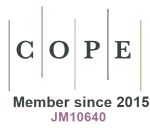Analytical performance of the FDA-cleared Parsortix® PC1 system
DOI:
https://doi.org/10.33393/jcb.2023.2629Keywords:
Blood, Breast cancer, Circulating tumor cells, Liquid biopsy, Microfluidic devices, Neoplastic cellsAbstract
Introduction: The Parsortix® PC1 system, Food and Drug Administration (FDA) cleared for use in metastatic breast cancer (MBC) patients, is an epitope-independent microfluidic device for the capture and harvest of circulating tumor cells from whole blood based on cell size and deformability. This report details the analytical characterization of linearity, detection limit, precision, and reproducibility for this device.
Methods: System performance was determined using K2-EDTA blood samples collected from self-declared healthy female volunteers (HVs) and MBC patients spiked with prelabeled cultured breast cancer cell lines (SKBR3, MCF7, or Hs578T). Samples were processed on Parsortix® PC1 systems and captured cells were harvested and enumerated.
Results: The system captured and harvested live SKBR3, MCF7, and Hs578T cells and fixed SKBR3 cells linearly between 2 and ~100 cells, with average harvest rates of 69%, 73%, 79%, and 90%, respectively. To harvest ≥1 cell ≥95% of the time, the system required 3, 5 or 4 live SKBR3, MCF7 or Hs578T cells, respectively. Average harvest rates from precision studies using 5, 10, and ~50 live cells spiked into blood for each cell line ranged from 63.5% to 76.2%, with repeatability and reproducibility percent coefficient of variation (%CV) estimates ranging from 12.3% to 32.4% and 13.3% to 34.1%, respectively. Average harvest rates using ~20 fixed SKBR3 cells spiked into HV and MBC patient blood samples were 75.0% ± 16.1% (%CV = 22.3%) and 68.4% ± 14.3% (%CV = 21.1%), respectively.
Conclusions: These evaluations demonstrate the Parsortix® PC1 system linearly and reproducibly harvests tumor cells from blood over a range of 1 to ~100 cells.
References
- Markou A, Tzanikou E, Lianidou E. The potential of liquid biopsy in the management of cancer patients. Semin Cancer Biol. 2022;84:69-79. https://doi.org/10.1016/j.semcancer.2022.03.013 PMID:35331850 DOI: https://doi.org/10.1016/j.semcancer.2022.03.013
- Russano M, Napolitano A, Ribelli G, et al. Liquid biopsy and tumor heterogeneity in metastatic solid tumors: the potentiality of blood samples. J Exp Clin Cancer Res. 2020;39(1):95. https://doi.org/10.1186/s13046-020-01601-2 PMID:32460897 DOI: https://doi.org/10.1186/s13046-020-01601-2
- Pantel K, Alix-Panabières C. Liquid biopsy and minimal residual disease—latest advances and implications for cure. Nat Rev Clin Oncol. 2019;16(7):409-424. https://doi.org/10.1038/s41571-019-0187-3 PMID:30796368 DOI: https://doi.org/10.1038/s41571-019-0187-3
- Rushton AJ, Nteliopoulos G, Shaw JA, Coombes RC. A review of circulating tumour cell enrichment technologies. Cancers (Basel). 2021;13(5):970. https://doi.org/10.3390/cancers13050970 PMID:33652649 DOI: https://doi.org/10.3390/cancers13050970
- Lin D, Shen L, Luo M, et al. Circulating tumor cells: biology and clinical significance. Signal Transduct Target Ther. 2021;6(1):404. https://doi.org/10.1038/s41392-021-00817-8 PMID:34803167 DOI: https://doi.org/10.1038/s41392-021-00817-8
- Dongre A, Weinberg RA. New insights into the mechanisms of epithelial-mesenchymal transition and implications for cancer. Nat Rev Mol Cell Biol. 2019;20(2):69-84. https://doi.org/10.1038/s41580-018-0080-4 PMID:30459476 DOI: https://doi.org/10.1038/s41580-018-0080-4
- Eslami-S Z, Cortés-Hernández LE, Thomas F, Pantel K, Alix-Panabières C. Functional analysis of circulating tumour cells: the KEY to understand the biology of the metastatic cascade. Br J Cancer. 2022;127(5):800-810. https://doi.org/10.1038/s41416-022-01819-1 PMID:35484215 DOI: https://doi.org/10.1038/s41416-022-01819-1
- Aceto N, Bardia A, Miyamoto DT, et al. Circulating tumor cell clusters are oligoclonal precursors of breast cancer metastasis. Cell. 2014;158(5):1110-1122. https://doi.org/10.1016/j.cell.2014.07.013 PMID:25171411 DOI: https://doi.org/10.1016/j.cell.2014.07.013
- Seyfried TN, Huysentruyt LC. On the origin of cancer metastasis. Crit Rev Oncog. 2013;18(1-2):43-73. https://doi.org/10.1615/CritRevOncog.v18.i1-2.40 PMID:23237552 DOI: https://doi.org/10.1615/CritRevOncog.v18.i1-2.40
- Akpe V, Kim TH, Brown CL, Cock IE. Circulating tumour cells: a broad perspective. J R Soc Interface. 2020;17(168):20200065. https://doi.org/10.1098/rsif.2020.0065 DOI: https://doi.org/10.1098/rsif.2020.0065
- Sparano J, O’Neill A, Alpaugh K, et al. Association of circulating tumor cells with late recurrence of estrogen receptor-positive breast cancer: a secondary analysis of a randomized clinical trial. JAMA Oncol. 2018;4(12):1700-1706. https://doi.org/10.1001/jamaoncol.2018.2574 PMID:30054636 DOI: https://doi.org/10.1001/jamaoncol.2018.2574
- Trapp E, Janni W, Schindlbeck C, et al; SUCCESS Study Group. Presence of circulating tumor cells in high-risk early breast cancer during follow-up and prognosis. J Natl Cancer Inst. 2019;111(4):380-387. https://doi.org/10.1093/jnci/djy152 PMID:30312434 DOI: https://doi.org/10.1093/jnci/djy152
- Riethdorf S, Müller V, Loibl S, et al. Prognostic impact of circulating tumor cells for breast cancer patients treated in the neoadjuvant “Geparquattro” trial. Clin Cancer Res. 2017;23(18):5384-5393. https://doi.org/10.1158/1078-0432.CCR-17-0255 PMID:28679772 DOI: https://doi.org/10.1158/1078-0432.CCR-17-0255
- Bidard F-C, Michiels S, Riethdorf S, et al. Circulating tumor cells in breast cancer patients treated by neoadjuvant chemotherapy: a meta-analysis. J Natl Cancer Inst. 2018;110(6):560-567. https://doi.org/10.1093/jnci/djy018 PMID:29659933 DOI: https://doi.org/10.1093/jnci/djy018
- Janni WJ, Rack B, Terstappen LWMM, et al. Pooled analysis of the prognostic relevance of circulating tumor cells in primary breast cancer. Clin Cancer Res. 2016;22(10):2583-2593. https://doi.org/10.1158/1078-0432.CCR-15-1603 PMID:26733614 DOI: https://doi.org/10.1158/1078-0432.CCR-15-1603
- Rack B, Schindlbeck C, Jückstock J, et al; SUCCESS Study Group. Circulating tumor cells predict survival in early average-to-high risk breast cancer patients. J Natl Cancer Inst. 2014;106(5):dju066. https://doi.org/10.1093/jnci/dju066 PMID:24832787 DOI: https://doi.org/10.1093/jnci/dju066
- Ring A, Campo D, Porras TB, et al. Circulating tumor cell transcriptomics as biopsy surrogates in metastatic breast cancer. Ann Surg Oncol. 2022;29(5):2882-2894. https://doi.org/10.1245/s10434-021-11135-2 PMID:35000083 DOI: https://doi.org/10.1245/s10434-021-11135-2
- Habli Z, AlChamaa W, Saab R, Kadara H, Khraiche ML. Circulating tumor cell detection technologies and clinical utility: challenges and opportunities. Cancers (Basel). 2020;12(7):1930. https://doi.org/10.3390/cancers12071930 PMID:32708837 DOI: https://doi.org/10.3390/cancers12071930
- Descamps L, Le Roy D, Deman A-L. Microfluidic-based technologies for CTC isolation: a review of 10 years of intense efforts towards liquid biopsy. Int J Mol Sci. 2022;23(4):1981. https://doi.org/10.3390/ijms23041981 PMID:35216097 DOI: https://doi.org/10.3390/ijms23041981
- Francart M-E, Lambert J, Vanwynsberghe AM, et al. Epithelial-mesenchymal plasticity and circulating tumor cells: travel companions to metastases. Dev Dyn. 2018;247(3):432-450. https://doi.org/10.1002/dvdy.24506 PMID:28407379 DOI: https://doi.org/10.1002/dvdy.24506
- Bankó P, Lee SY, Nagygyörgy V, et al. Technologies for circulating tumor cell separation from whole blood. J Hematol Oncol. 2019;12(1):48. https://doi.org/10.1186/s13045-019-0735-4 PMID:31088479 DOI: https://doi.org/10.1186/s13045-019-0735-4
- Miller MC, Robinson PS, Wagner C, O’Shannessy DJ. The Parsortix™ Cell Separation System—a versatile liquid biopsy platform. Cytometry A. 2018;93(12):1234-1239. https://doi.org/10.1002/cyto.a.23571 PMID:30107082 DOI: https://doi.org/10.1002/cyto.a.23571
- Hvichia GE, Parveen Z, Wagner C, et al. A novel microfluidic platform for size and deformability based separation and the subsequent molecular characterization of viable circulating tumor cells. Int J Cancer. 2016;138(12):2894-2904. https://doi.org/10.1002/ijc.30007 PMID:26789903 DOI: https://doi.org/10.1002/ijc.30007
- Gorges TM, Kuske A, Röck K, et al. Accession of tumor heterogeneity by multiplex transcriptome profiling of single circulating tumor cells. Clin Chem. 2016;62(11):1504-1515. https://doi.org/10.1373/clinchem.2016.260299 PMID:27630154 DOI: https://doi.org/10.1373/clinchem.2016.260299
- Xu L, Mao X, Guo T, et al. The novel association of circulating tumor cells and circulating megakaryocytes with prostate cancer prognosis. Clin Cancer Res. 2017;23(17):5112-5122. https://doi.org/10.1158/1078-0432.CCR-16-3081 PMID:28615267 DOI: https://doi.org/10.1158/1078-0432.CCR-16-3081
- Maertens Y, Humberg V, Erlmeier F, et al. Comparison of isolation platforms for detection of circulating renal cell carcinoma cells. Oncotarget. 2017;8(50):87710-87717. https://doi.org/10.18632/oncotarget.21197 PMID:29152114 DOI: https://doi.org/10.18632/oncotarget.21197
- Koch C, Joosse SA, Schneegans S, et al. Pre-analytical and analytical variables of label-independent enrichment and automated detection of circulating tumor cells in cancer patients. Cancers (Basel). 2020;12(2):442. https://doi.org/10.3390/cancers12020442 PMID:32069934 DOI: https://doi.org/10.3390/cancers12020442
- Zavridou M, Mastoraki S, Strati A, et al. Direct comparison of size-dependent versus EpCAM-dependent CTC enrichment at the gene expression and DNA methylation level in head and neck squamous cell carcinoma. Sci Rep. 2020;10(1):6551. https://doi.org/10.1038/s41598-020-63055-y PMID:32300118 DOI: https://doi.org/10.1038/s41598-020-63055-y
- Chudziak J, Burt DJ, Mohan S, et al. Clinical evaluation of a novel microfluidic device for epitope-independent enrichment of circulating tumour cells in patients with small cell lung cancer. Analyst (Lond). 2016;141(2):669-678. https://doi.org/10.1039/C5AN02156A PMID:26605519 DOI: https://doi.org/10.1039/C5AN02156A
- Gong Y, Liu Y-R, Ji P, Hu X, Shao Z-M. Impact of molecular subtypes on metastatic breast cancer patients: a SEER population-based study. Sci Rep. 2017;7(1):45411. https://doi.org/10.1038/srep45411 PMID:28345619 DOI: https://doi.org/10.1038/srep45411
- Yu M, Bardia A, Wittner BS, et al. Circulating breast tumor cells exhibit dynamic changes in epithelial and mesenchymal composition. Science. 2013;339(6119):580-584. https://doi.org/10.1126/science.1228522 PMID:23372014 DOI: https://doi.org/10.1126/science.1228522
- Dai X, Cheng H, Bai Z, Li J. Breast cancer cell line classification and its relevance with breast tumor subtyping. J Cancer. 2017;8(16):3131-3141. https://doi.org/10.7150/jca.18457 PMID:29158785 DOI: https://doi.org/10.7150/jca.18457
- Liu K, Newbury PA, Glicksberg BS, et al. Evaluating cell lines as models for metastatic breast cancer through integrative analysis of genomic data. Nat Commun. 2019;10(1):2138. https://doi.org/10.1038/s41467-019-10148-6 PMID:31092827 DOI: https://doi.org/10.1038/s41467-019-10148-6
- Cohen EN, Jayachandran G, Moore RG, et al. A multi-center clinical study to harvest and characterize circulating tumor cells from patients with metastatic breast cancer using the Parsortix® PC1 system. Cancers (Basel). 2022;14(21):5238. https://doi.org/10.3390/cancers14215238 PMID:36358657 DOI: https://doi.org/10.3390/cancers14215238
- Coumans FAW, van Dalum G, Beck M, Terstappen LWMM. Filter characteristics influencing circulating tumor cell enrichment from whole blood. PLoS One. 2013;8(4):e61770. https://doi.org/10.1371/journal.pone.0061770 PMID:23626725 DOI: https://doi.org/10.1371/journal.pone.0061770
- Zhao W, Liu Y, Jenkins BD, et al. Tumor antigen-independent and cell size variation-inclusive enrichment of viable circulating tumor cells. Lab Chip. 2019;19(10):1860-1876. https://doi.org/10.1039/C9LC00210C PMID:31041975 DOI: https://doi.org/10.1039/C9LC00210C
- Hao S-J, Wan Y, Xia Y-Q, Zou X, Zheng S-Y. Size-based separation methods of circulating tumor cells. Adv Drug Deliv Rev. 2018;125:3-20. https://doi.org/10.1016/j.addr.2018.01.002 PMID:29326054 DOI: https://doi.org/10.1016/j.addr.2018.01.002
- Coumans F, van Dalum G, Terstappen LWMM. CTC technologies and tools. Cytometry A. 2018;93(12):1197-1201. https://doi.org/10.1002/cyto.a.23684 PMID:30548774 DOI: https://doi.org/10.1002/cyto.a.23684










